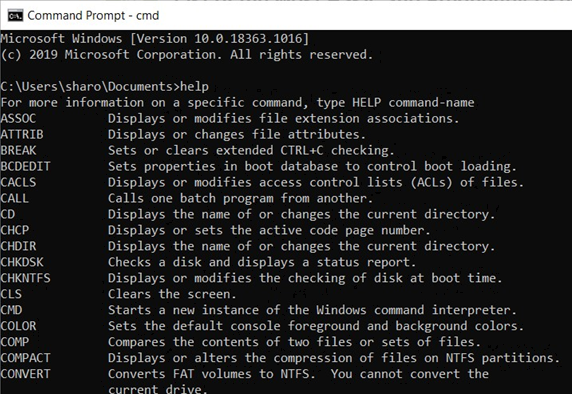


XCOPY can be used in place of COPY to provide the following advantages: /? - displays help for a specified command.NET USER - manages user accounts (add, remove, change).NET USE - connects to shared folders similar to mapping a network drive.ROBOCOPY - Robust File Copy copies or moves files/folders.XCOPY - copies one or more files & folders to another folder or drive.COPY - copies one or more files to another folder or drive.FORMAT - creates or recreates the specified file system on recordable or rewritable storage (magnetic, flash, or optical) & overwrites the contents of the drive.GPRESULT - displays the resultant set of policy for the specified computer & user.GPUPDATE - refreshes group policy on local or Active Directory systems.TASKKILL - stops specified tasks on a local or remote computer.DISKPART - creates, removes, & manages disk partitions (must be run in admin mode).CHKDSK - scans specified drive for errors & repairs them (must be run in admin mode).SFC - System File Checker scans system files & replaces damaged or missing files (must be run in admin mode).DISM - Deployment Image Servicing & Management services images.NSLOOKUP - gathers the network’s DNS (domain name system/server) information.NETSTAT - displays a list of active TCP connections on a local network.TRACERT - similar to PING but returns path information to an IP address destination in macOS & Linux the command is TRACEROUTE.PING - sends IP packets to check network connectivity.IPCONFIG - displays TCP/IP network information on a computer.CD (CHDIR) - changes the working directory.DIR - displays list of the current folder’s files & subfolders.Keep in mind that commands can be entered in lowercase, uppercase, or mixed case. Display or configure operating system settings.Reinstall lost or corrupted system files.Data recovery from systems that cannot boot manually.Type “ cmd” & then press OK to open a command prompt.Ĭommand prompt is often used to do the following by technicians: You can also press Windows+R to open the “Run” box.
#Basic command prompt commands windows
In Windows 8/8.1 & 10, you can press Windows+X & then click Command Prompt to run in standard mode ( Command Prompt (Admin)) to run in administrator mode.


 0 kommentar(er)
0 kommentar(er)
